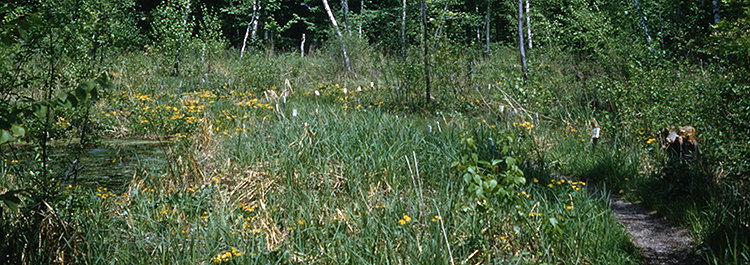
1926
History
of the Eloise Butler Wildflower Garden
This winter Eloise Butler was on to the East Coast to visit her relatives, as had been her custom since she retired from teaching in 1911. Her residence was at 20 Murray Hill Rd, Malden, Mass.
She wrote to Bill and Martha Crone in January about the Christmas gifts, especially the reel tape measure, and the recipes the Crones sent and noted that the weather in Malden had been mild. Another of the presents received from the Crones was "the account of our Little Sahara." (1) This is the first time this term shows up and it refers to the sand garden and Cactus Rockery that was created as early as 1924. The words "little Sahara" do not show up in Eloise's log notes until June 1930, but this correspondence affirms the much earlier start of this garden area.
In late March she returned to her rented quarters at the residence of John and Susan Babcock at 227 Xerxes Ave. from where she could walk to the Garden.
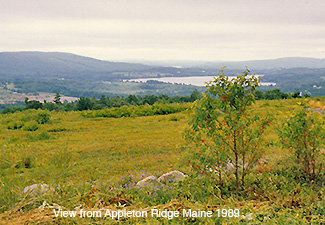
Eloise Butler’s first Garden Log note of the season was on April 1st when she wrote:
“No snow on the ground, but ice still on the ponds. Season very late. Robins and bluebirds here.” On the 13th Trillium nivale [Snow Trillium] was in bloom and the Hepaticas were budding. But late winter was not over - on May 13: “Frost at night, young leaves of butternut frozen.”
Once again the pheasant was nesting. May 19: “Noted pheasant’s nest on west hillside with 10 eggs; yellow-headed blackbird’s nest June 4 with 4 small eggs, one small, probably cowbird’s egg.” 14 June: “Noted exquisite nest of American Goldfinch in showy lady slipper meadow four eggs in it.” (Garden Log)
No new species were introduced this spring but she did receive shipments of plants already in the Garden from Robbins’ Nursery in Ashford NC; from North Dakota, and Malden, MA. She sourced locally from Hardscrabble Point on Lake Minnetonka, and from Forest Lake.
On May 31st Fletcher Wilson wrote in the Minneapolis Tribune about the flower displays in the city parks, devoting the most space to the Wild Flower Garden. He wrote:
And last, but of course not least, the native plant reserve in Glenwood . . . under the scrupulous care of
a little old woman, Miss Eloise Butler. Except for fences and signs, it looks like a particularly beautiful spot in the wilds that has remained un-disfigured by the encroachment of civilization. There are no set beds. The plants have been introduced under their native conditions and allowed top grow as they will. In the reserve one may find in a restricted area plants which one would otherwise have to roam the entire state to see.
After reading that one must suspect that he had a lesson with Miss Butler as it reads almost directly from her own written words except for the description of her as "a little old woman."
In the summer months Eloise obtained another four new species for the Garden. Details below.
During 1926 Eloise wrote a summary of Shrubs in the Wild Garden, in which she reviewed her inventory of shrubs. She started with “The brightly hued berries of the shrubs are but a 'fleeting show' in the garden, being scarcely allowed to ripen by the fruit-loving birds.” At the end of the essay she gave an inventory:
The ten shrubs most common in the Reserve are: willows, of which the most abundant are Salix discolor [Pussy Willow], S. petiolaris [Slender Willow], S. rostrata [S. bebbiana, Bebb Willow]; Common hazel (Corylus americana); Prickly ash (Xanthoxylum americanum); Beaked hazel (Corylus rostrata); Smooth sumach (Rhus glabra); Gray dogwood (Cornus paniculata); Red-osier dogwood (Cornus stolonifera); Dwarf birch (Betula pumila); Wild buckthorn (Rhamus alnifolia); Round-leaved thorn (Crataegus rotundifolia) [Crataegus chrysocarpa var. chrysocarpa]. (2)
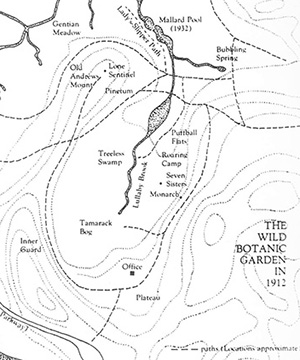
In the autumn months Eloise obtained 3 new species for the Garden, detailed below.
Eloise did not refer to warblers very often but on September 6th she wrote: “Mrs. Gaylord Davidson noted today in The Reserve the following warblers” and listed 13 plus 17 other birds.
Sometime during the year she added notes to what she intended to be an early history of the wildlife reserve. She described in this essay the layout of the Garden in the area she called the “plateau” where her office stood. Then she added notes about the evergreens in the Garden. Read it all here.
Her last log entry on October 22 said “planted from Grand Forks N. Dakota 7 silverberry below east path near Buffalo Berry. Planted from Glenwood Park 1 Aster azureus and 1 A. sericeus on Plateau north of office.” Frosts occurred on October 24-25th ending the growing season.
During the autumn she also recorded planting a number of other species previously in the Garden, most from Robbins in Ashford NC; Waseca MN; Royal NE, Thomaston ME; Mrs. Leavitt’s garden at 2015 James Ave. So, Minneapolis; Glenwood Park; Deephaven MN; a large group of plants from Bryan MN; the Parkboard Nursery; the Streetcar terminus on West Broadway and Mrs. Johnson’s yard in Minneapolis.
A third essay this year, also intended to be part of her history was titled Trees in the Wild Garden. She recounted “A census was taken at once of the most obvious inmates of the Reserve, which has been increased from time to time by many delightful surprises.” (3) She references the damage from the tornado in 1925 and then lists this inventory:
“The ten most abundant trees in the Native Plant Reserve, Minneapolis, are: Tamarack (Larix laricina), White birch (Betula alba var. papyrifera), Ironwood (Ostrya virginiana), Northern pin oak (Quercus ellipsoidalis), White oak (Quercus alba), Red oak (Quercus rubra), White ash (Fraximus americana), Red maple (Acer rubrum), Basswood, (Tilia americana), Large-toothed aspen (Populus grandidentata).” (3)
When the Garden closed and the office locked up she departed for the East Coast to visit her sister Cora Pease as she has done every winter since 1911.
In another part of the history Eloise was writing about the Garden, dated 1926, she wrote of the earliest days of the Garden, why preservation was necessary and why the spot was chosen. "In the early ‘80s Minneapolis was a place of enchantment – a veritable fairyland," but with the advancement of the city "The land has been ruthlessly stripped of the exquisite features that Nature, the greatest landscape gardener, has wrought through the ages, and “all the king’s horses and all the king’s men” can never make the place the same again." Read the entire essay here.
Following the death of Eloise in 1933, parts of her text were incorporated into an article titled Our Native Plant Reserve compiled by Mrs. John Jepson. The purpose of the article was to sum up the work Eloise had done and the benefit of the Garden to society. The text was then published in The Minnesota Clubwoman in June 1933. (PDF of published article)
Weather in 1926 was not too unusual. Precipitation increased from 1925, but the year was still below normal by 3 inches. The year ended with some good snow and snow on the ground most of November and all of December.
New 1926 Plants
Eloise brought into the Garden a number of plants that are not listed today on the Garden census. Many of these were native to Minnesota and a few were not. Here is a listing of most of those plants introduced this year to the Garden for the first time - the common and botanical names listed first are names she used followed by other common names for the same plant and the newer botanical classifications, if any; then follows her source for the material. 1926 is the first year the following list of plants occur in her log. "Native" indicates the plant is considered native to Minnesota (here at European Settlement time) or if introduced, long established. "Non-native" indicates it is not known to exist in Minnesota in the wild. "Introduced" means not native to North America. "Extant" indicates the plant is present in the Garden today. Botanical classification: Over the years Botanists have reclassified many plants from the classifications in use at the time Eloise Butler wrote her Garden Log or when Martha Crone prepared her census. I have retained the nomenclature that Eloise Butler or Martha Crone used and then provided the more current classification as used by the major listings in use today, particularly Flora of North America and the University of Minnesota's Checklist of the Vascular Flora of Minnesota.
Spring 1926
No new species in spring 1926.
Summer 1926
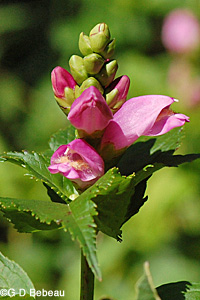
- Aster shortii, [Symphyotrichum shortii], Short’s Aster, native, from Waseca. MN. August 28 with a 2nd group on September 4. Extant.
- Chelone obliqua, Red Turtlehead, from Vicinity of Waterville, near southern boundary of Rice County, 1 clump, August 14. This had been naturalized in Mr. Rohl’s garden, Gramercy Ave. There has long been a question whether this species has native status in Minnesota. The Checklist of the Vascular Plants of Minnesota (Ref. #28C) states it is known only from Southern Minnesota and last collected in 1922. This clump was later stolen and Policeman Rohl replaced the clump with others from his garden on May 23, 1931. Extant.
- Hydrophyllum appendiculatum, Great Waterleaf, native, from Denison Iowa, July 31.
- Mentzelia decapetala, Tenpetal Blazing Star, not native to MN, from Beulah, ND, August 26,
Autumn 1926
- Aster nemoralis [Oclemena nemoralis] Bog aster, not native, from Thomaston, ME, September 3.
- Erigeron annuus, Eastern Daisy Fleabane [Annual Fleabane], native, from Deephaven, September 30. This is the first time she planted it, but was indigenous in 1907. Extant.
- Silphium integrifolium, Rosinweed, not native, from Royal Neb. October 9. Extant.
- Specularia perfoliata, [Triodanis perfoliata] Clasping Venus Looking-glass, native, seeds from Royal Nebraska, October 18. Martha Crone also planted it in 1947.

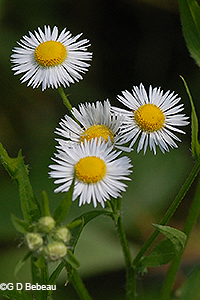
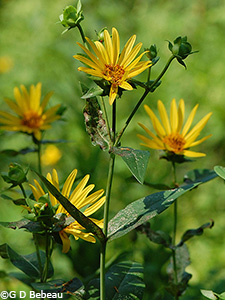
Photo top of page: One of the open pools in the wetland as seen years later on May 15, 1952. This pool did not exist in 1926. Photo from a Kodachrome taken by Martha Crone. These Kodachromes were given to Friends of the Wild Flower Garden by Martha Crone Estate.
Printable PDF file of this page.
Notes:
(1) Letter to Bill and Martha Crone, 11 Jan. 1926 (pdf)
(2) Shrubs in the Wild Garden, essay in The Early History of the Wildlife Reserve, unpublished.
(3) Trees in the Wild Garden. essay in The Early History of the Wildlife Reserve, unpublished.
Links to related pages:
- Abbreviated Life of Eloise Butler
- Martha Crone - 2nd Garden Curator
- Ken Avery - 3rd Curator and Gardener
- Cary George - 4th Gardener
- Our Native Plant Reserve - Short document on the origins of the Garden.
- Eloise Butler's writings, a selection of essays written by Eloise Butler on the early Garden years.
- Geography of the Garden- an illustrated tour
References:
Garden Log - Native Plant Reserve, Glenwood Park, Minneapolis, MN by Eloise Butler.
Martha Crone's Garden Log and her 1951 Census of plants in the Garden.
Various papers and correspondence of Eloise Butler in the collection of the Minnesota Historical Society.
Historical Climatology of Minneapolis-St. Paul Area by Charles Fisk.